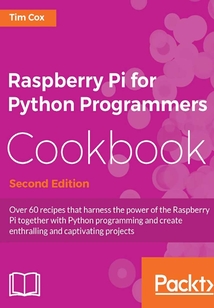首頁 > 計(jì)算機(jī)網(wǎng)絡(luò) >
編程語言與程序設(shè)計(jì)
> Raspberry Pi for Python Programmers Cookbook(Second Edition)最新章節(jié)目錄
舉報(bào) 

會(huì)員
Raspberry Pi for Python Programmers Cookbook(Second Edition)
最新章節(jié):
Index
ReadersareexpectedtobefamiliarwithprogrammingconceptsandPython(wherepossiblePython3isused),althoughbeginnersshouldmanagewiththehelpofagoodPythonreferencebookandbackgroundreading.NopriorknowledgeoftheRaspberryPiorelectronicsisrequired;however,forthehardwaresectionsyouwillneedsomebasicelectroniccomponents/householdtoolstobuildsomeoftheprojects.
目錄(95章)
倒序
- 封面
- 版權(quán)頁
- Credits
- About the Author
- About the Reviewer
- www.PacktPub.com
- eBooks discount offers and more
- Preface
- What this book covers
- What you need for this book
- Who this book is for
- Safety and using electronics
- Sections
- Conventions
- Reader feedback
- Customer support
- Chapter 1. Getting Started with a Raspberry Pi Computer
- Introduction
- Connecting the Raspberry Pi
- Using NOOBS to set up your Raspberry Pi SD card
- Networking and connecting your Raspberry Pi to the Internet via the LAN connector
- Using built-in Wi-Fi and Bluetooth on the Raspberry Pi
- Configuring your network manually
- Networking directly to a laptop or computer
- Networking and connecting your Raspberry Pi to the Internet via a USB Wi-Fi dongle
- Connecting to the Internet through a proxy server
- Connecting remotely to the Raspberry Pi over the network using VNC
- Connecting remotely to the Raspberry Pi over the network using SSH (and X11 Forwarding)
- Sharing the home folder of the Raspberry Pi with SMB
- Keeping the Raspberry Pi up to date
- Chapter 2. Starting with Python Strings Files and Menus
- Introduction
- Working with text and strings
- Using files and handling errors
- Creating a boot-up menu
- Creating a self-defining menu
- Chapter 3. Using Python for Automation and Productivity
- Introduction
- Using Tkinter to create graphical user interfaces
- Creating a graphical application – Start menu
- Displaying photo information in an application
- Organizing your photos automatically
- Chapter 4. Creating Games and Graphics
- Introduction
- Using IDLE3 to debug your programs
- Drawing lines using a mouse on Tkinter Canvas
- Creating a bat and ball game
- Creating an overhead scrolling game
- Chapter 5. Creating 3D Graphics
- Introduction
- Starting with 3D coordinates and vertices
- Creating and importing 3D models
- Creating a 3D world to roam in
- Building 3D maps and mazes
- Chapter 6. Using Python to Drive Hardware
- Introduction
- Controlling an LED
- Responding to a button
- A controlled shutdown button
- The GPIO keypad input
- Multiplexed color LEDs
- Writing messages using Persistence of Vision
- Chapter 7. Sense and Display Real-World Data
- Introduction
- Using devices with the I2C bus
- Reading analog data using an analog-to-digital converter
- Logging and plotting data
- Extending the Raspberry Pi GPIO with an I/O expander
- Capturing data in an SQLite database
- Viewing data from your own webserver
- Sensing and sending data to online services
- Chapter 8. Creating Projects with the Raspberry Pi Camera Module
- Introduction
- Getting started with the Raspberry Pi camera module
- Using the camera with Python
- Generating a time-lapse video
- Creating a stop frame animation
- Making a QR code reader
- Discover and experiment with OpenCV
- Color detection with OpenCV
- Performing motion tracking with OpenCV
- Chapter 9. Building Robots
- Introduction
- Building a Rover-Pi robot with forward driving motors
- Using advanced motor control
- Building a six-legged Pi-Bug robot
- Controlling servos directly with Servoblaster
- Using an Infra-Red Remote Control with your Raspberry Pi
- Avoiding objects and obstacles
- Getting a sense of direction
- Chapter 10. Interfacing with Technology
- Introduction
- Automating your home with remote sockets
- Appendix A. Hardware and Software List
- Index 更新時(shí)間:2021-08-20 10:22:30
推薦閱讀
- Beginning Java Data Structures and Algorithms
- Oracle Exadata性能優(yōu)化
- WebAssembly實(shí)戰(zhàn)
- 零基礎(chǔ)玩轉(zhuǎn)區(qū)塊鏈
- Reactive Programming With Java 9
- 編程數(shù)學(xué)
- Learning Salesforce Einstein
- NetBeans IDE 8 Cookbook
- Python 3 Object:oriented Programming(Second Edition)
- Arduino機(jī)器人系統(tǒng)設(shè)計(jì)及開發(fā)
- 分布式架構(gòu)原理與實(shí)踐
- SQL Server 2012 數(shù)據(jù)庫應(yīng)用教程(第3版)
- 算法精解:C語言描述
- Python深度學(xué)習(xí)(第2版)
- H5匠人手冊(cè):霸屏H5實(shí)戰(zhàn)解密
- Learning QGIS(Second Edition)
- JSP編程教程
- Developing RESTful Web Services with Jersey 2.0
- 實(shí)戰(zhàn)圖解MACD波段交易技術(shù)
- LabVIEW虛擬儀器項(xiàng)目開發(fā)與實(shí)踐
- Metasploit for Beginners
- C++從入門到精通(第4版)
- 新時(shí)期的Node.js入門
- Python地球科學(xué)數(shù)據(jù)分析
- 輕松玩轉(zhuǎn)Python少兒編程
- Dapr與.NET微服務(wù)實(shí)戰(zhàn)
- C語言程序設(shè)計(jì)實(shí)訓(xùn)指導(dǎo)與習(xí)題
- Mastering Magento 2(Second Edition)
- Android深入淺出
- 并發(fā)模式與應(yīng)用實(shí)踐

